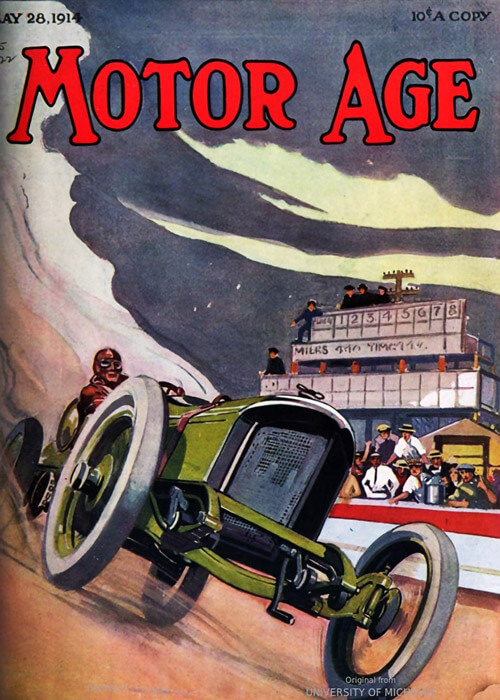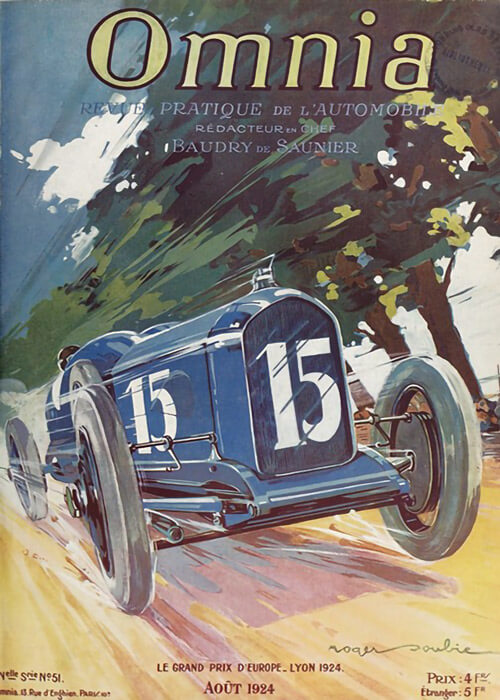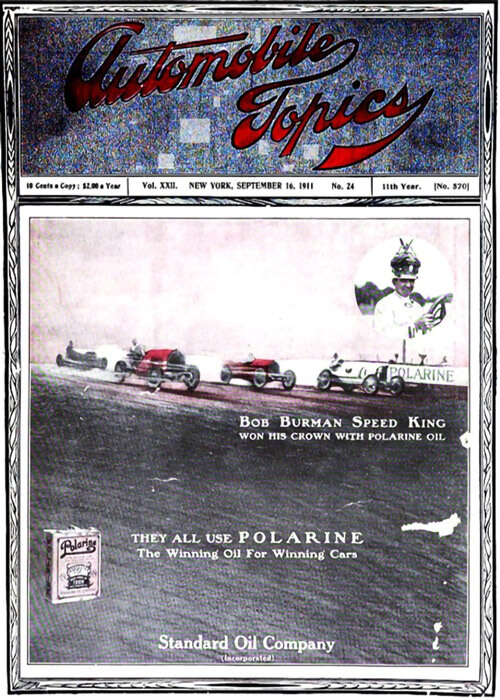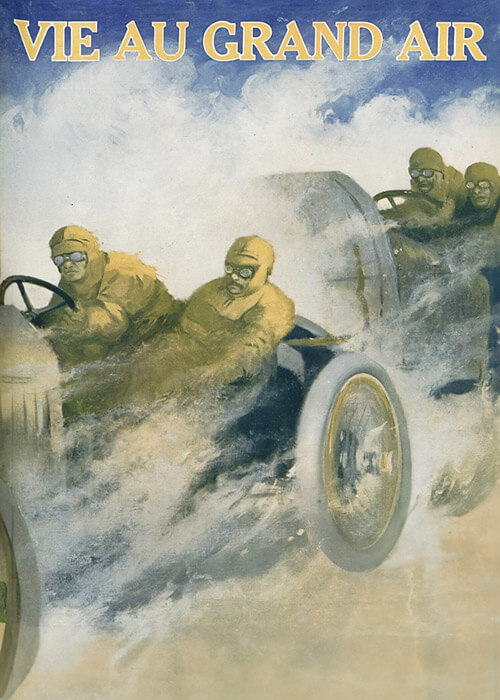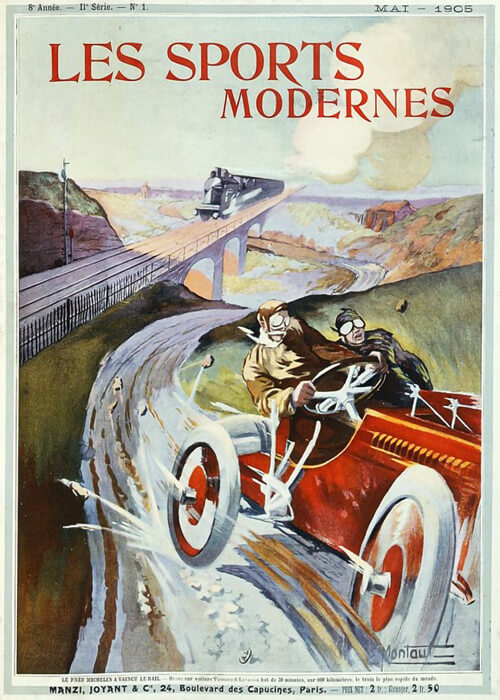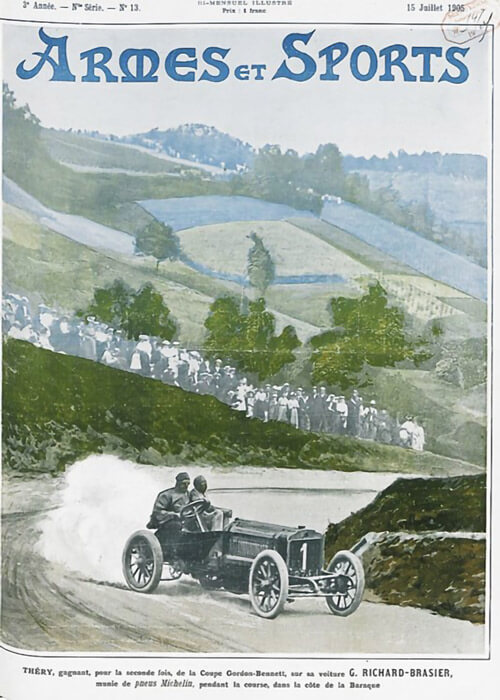„A pictorial history of the American automobile, as seen in Motor Magazine 1903-1953“, by Philip Van Doren Stern. This 1953 book explains a large part of the first fifty years American automotive history, covered in over just more than 250 pages. This part below deals with the 1895 November Times-Herald contest in Chicago.
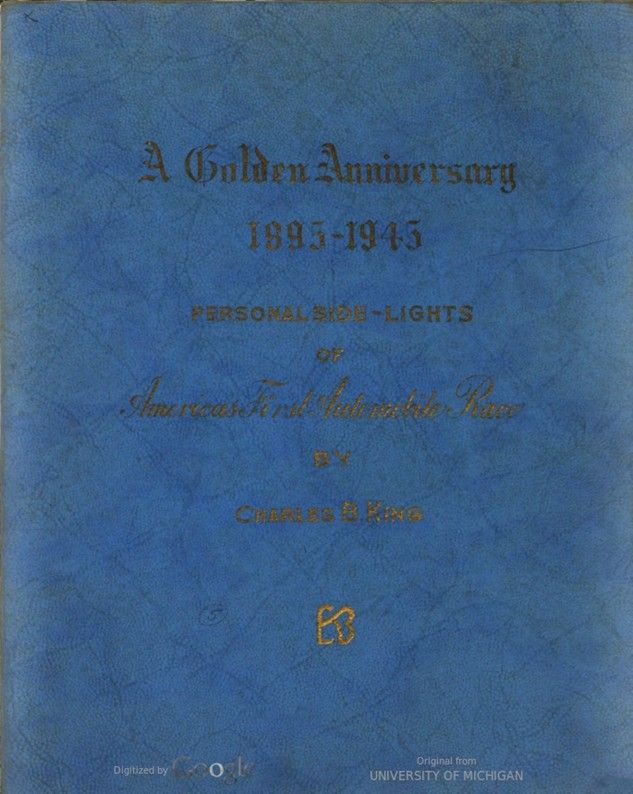
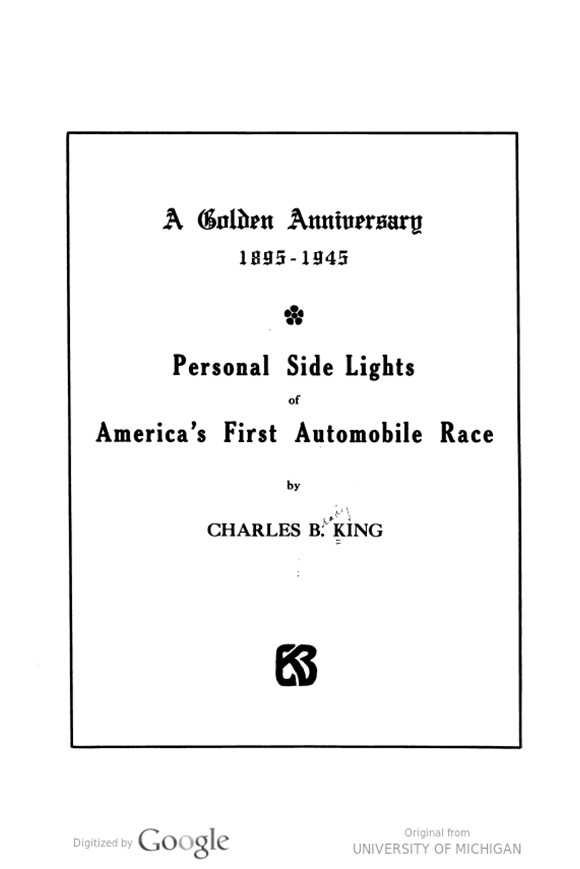
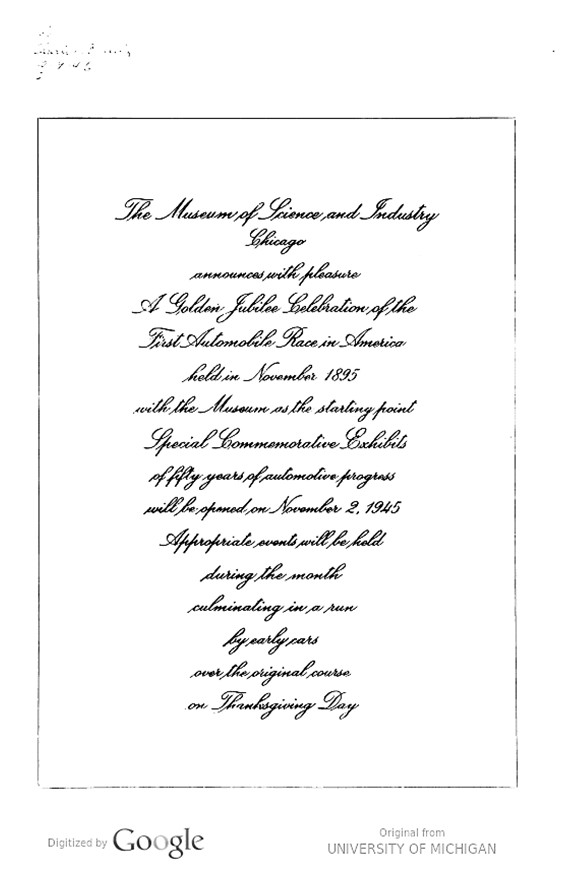
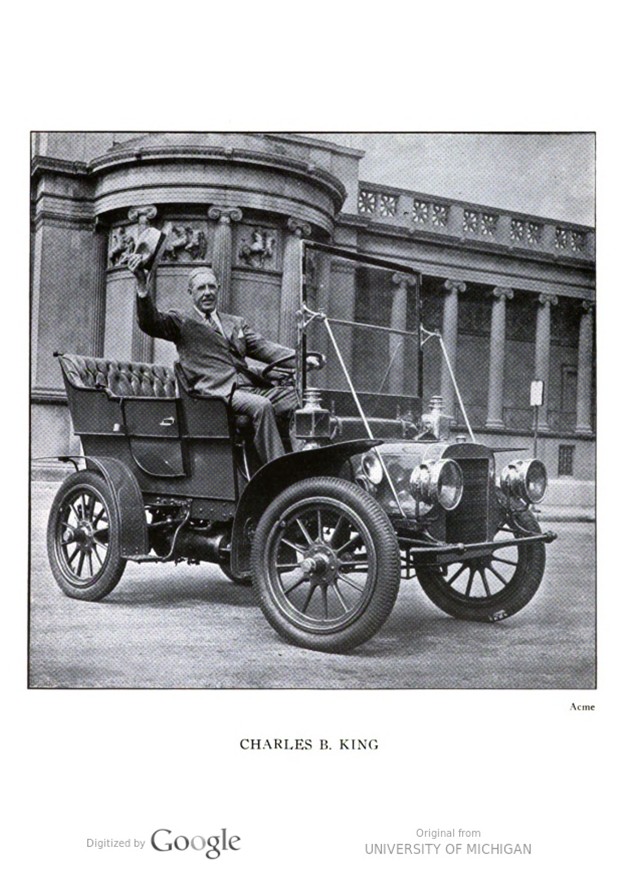
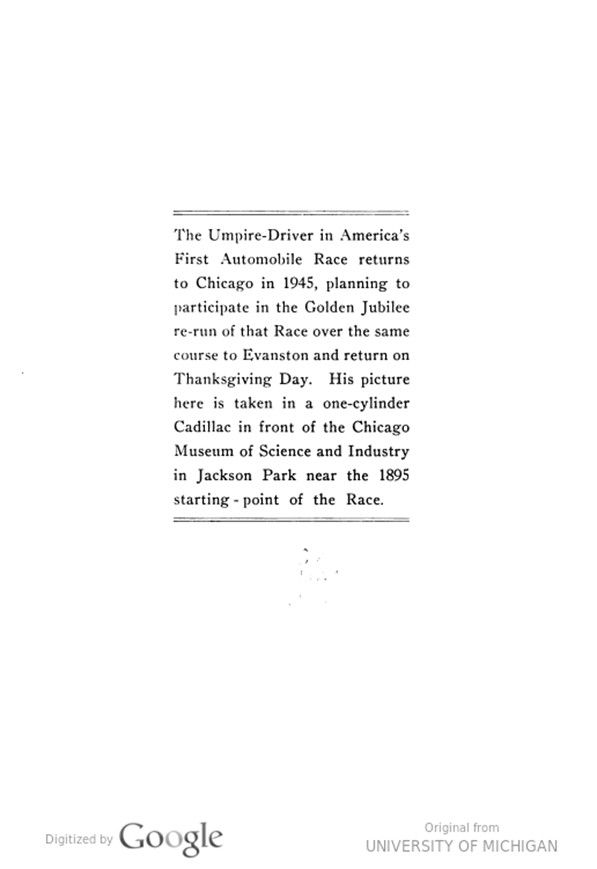
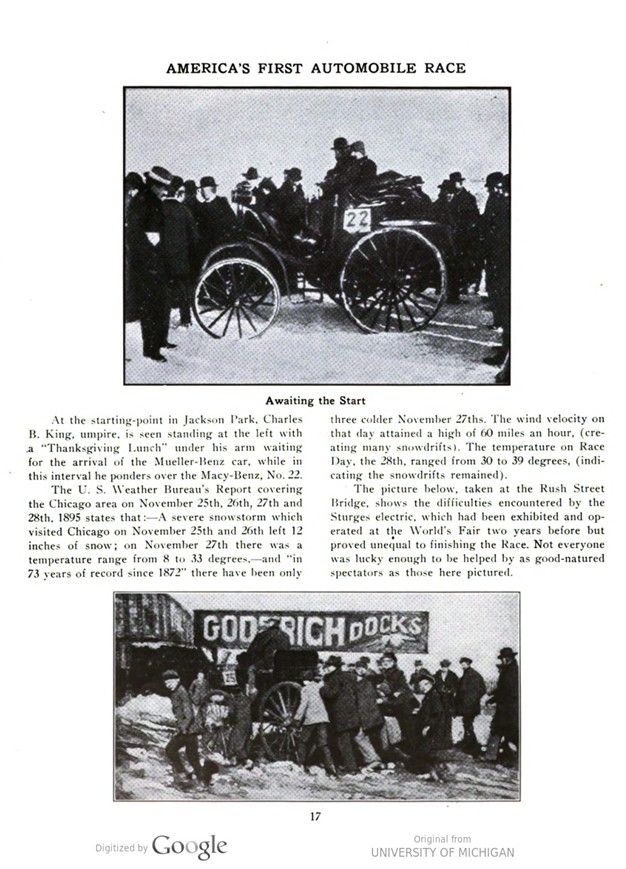
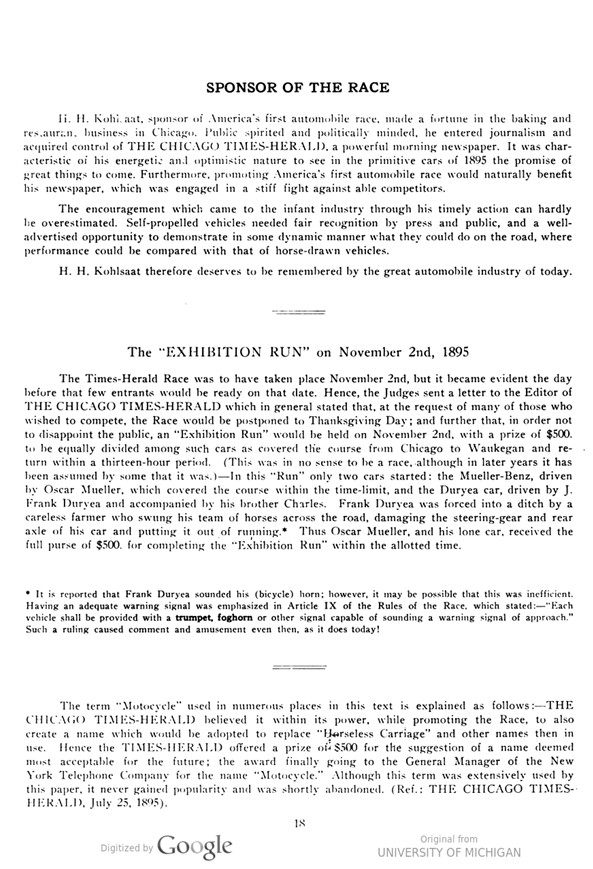
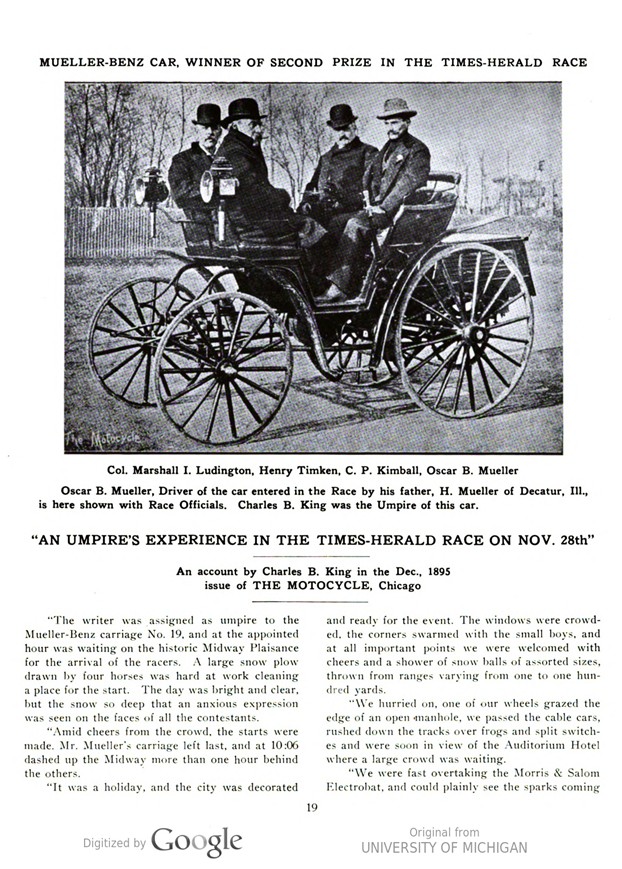
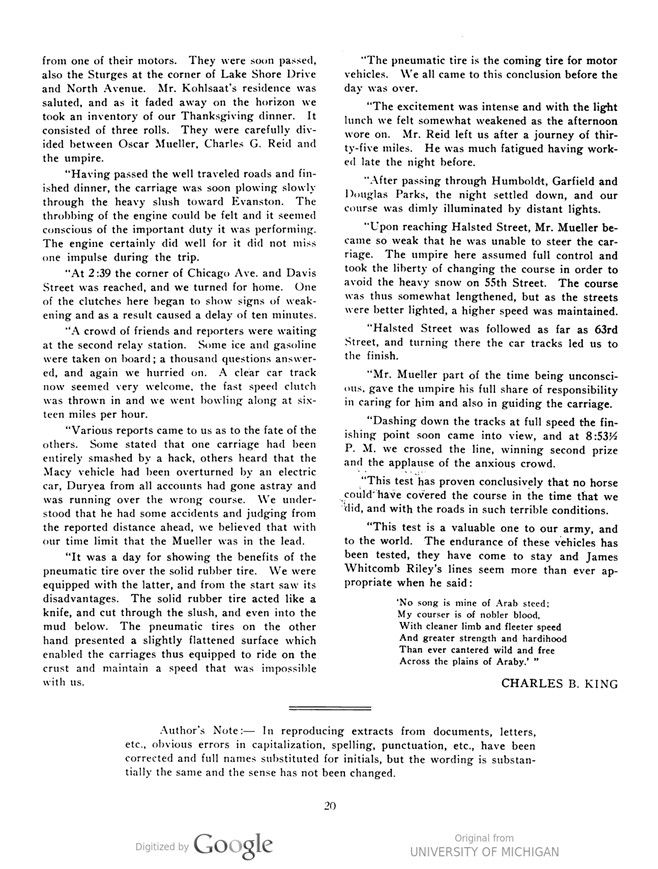
Text and photos with courtesy of hathitrust.org, www.hathitrust.org , compiled by motorracinghistory.
A Golden Anniversary 1895-1945
Personal Side Lights of America’s First Automobile Race by CHARLES B. KING
The Museum of Science and Industry Chicago announces with pleasure:
A Golden Jubilee Celebration of the First Automobile Race in America held in November 1895 with the Museum as the starting point. Special Commemorative Exhibits of fifty years of automotive progress will be opened on November 2, 1945. Appropriate events will be held during the month culminating in a run by early cars over the original course on Thanksgiving Day.
The Umpire-Driver in America’s First Automobile Race returns to Chicago in 1945, planning to participate in the Golden Jubilee re-run of that Race over the same course to Evanston and return on Thanksgiving Day. His picture here is taken in a one-cylinder Cadillac in front of the Chicago Museum of Science and Industry in Jackson Park near the 1895 starting point of the Race.
AMERICA’S FIRST AUTOMOBILE RACE
At the starting-point in Jackson Park, Charles B. King, umpire, is seen standing at the left with a „Thanksgiving Lunch“ under his arm waiting for the arrival of the Mueller-Benz car, while in this interval he ponders over the Macy-Benz, No. 22.
The U. S. Weather Bureau’s Report covering the Chicago area on November 25th, 26th, 27th and 28th, 1895 states that: – A severe snowstorm which visited Chicago on November 25th and 26th left 12 inches of snow; on November 27th there was a temperature range from 8 to 33 degrees, and „in 73 years of record since 1872“ there have been only three colder November 27ths. The wind velocity on that day attained a high of 60 miles an hour, (creating many snowdrifts). The temperature on Race Day, the 28th, ranged from 30 to 39 degrees, (indicating the snowdrifts remained).
The picture below, taken at the Rush Street Bridge, shows the difficulties encountered by the Sturges electric, which had been exhibited and operated at the World’s Fair two years before but proved unequal to finishing the Race. Not everyone was lucky enough to be helped by as good-natured spectators as those here pictured.
SPONSOR OF THE RACE
H. H. Kohlsaat, sponsor of America’s first automobile race, made a fortune in the baking and restaurant business in Chicago. Public spirited and politically minded, he entered journalism and acquired control of THE CHICAGO TIMES-HERALD, a powerful morning newspaper. It was characteristic of his energetic and optimistic nature to see in the primitive cars of 1895 the promise of great things to come. Furthermore, promoting America’s first automobile race would naturally benefit his newspaper, which was engaged in a stiff fight against able competitors.
The encouragement which came to the infant industry through his timely action can hardly be overestimated. Self-propelled vehicles needed fair recognition by press and public, and a well- advertised opportunity to demonstrate in some dynamic manner what they could do on the road, where performance could be compared with that of horse-drawn vehicles.
H. H. Kohlsaat therefore deserves to be remembered by the great automobile industry of today.
The „EXHIBITION RUN“ on November 2nd, 1895.
The Times-Herald Race was to have taken place November 2nd, but it became evident the day before that few entrants would be ready on that date. Hence, the Judges sent a letter to the Editor of THE CHICAGO TIMES-HERALD which in general stated that, at the request of many of those who wished to compete, the Race would be postponed to Thanksgiving Day; and further that, in order not to disappoint the public, an „Exhibition Run“ would be held on November 2nd, with a prize of $500. to be equally divided among such cars as covered the course from Chicago to Waukegan and re- turn within a thirteen-hour period. (This was in no sense to be a race, although in later years it has been assumed by some that it was.) – In this „Run“ only two cars started: the Mueller-Benz, driven by Oscar Mueller, which covered the course within the time-limit, and the Duryea car, driven by J. Frank Duryea and accompanied by his brother Charles. Frank Duryea was forced into a ditch by a careless farmer who swung his team of horses across the road, damaging the steering-gear and rear axle of his car and putting it out of running.* Thus Oscar Mueller, and his lone car, received the full purse of $500. for completing the „Exhibition Run“ within the allotted time.
* It is reported that Frank Duryea sounded his (bicycle) horn; however, it may be possible that this was inefficient. Having an adequate warning signal was emphasized in Article IX of the Rules of the Race, which stated: – „Each vehicle shall be provided with a trumpet, foghorn or other signal capable of sounding a warning signal of approach.“ Such a ruling caused comment and amusement even then, as it does today!
The term „Motocycle“ used in numerous places in this text is explained as follows: – THE CHICAGO TIMES-HERALD believed it within its power, while promoting the Race, to also create a name which would be adopted to replace „Horseless Carriage“ and other names then in use. Hence the TIMES-HERALD offered a prize of $500 for the suggestion of a name deemed most acceptable for the future; the award finally going to the General Manager of the New York Telephone Company for the name „Motocycle.“ Although this term was extensively used by this paper, it never gained popularity and was shortly abandoned. (Ref.: THE CHICAGO TIMES– HERALD, July 25, 1895).
MUELLER-BENZ CAR, WINNER OF SECOND PRIZE IN THE TIMES-HERALD RACE
Col. Marshall I. Ludington, Henry Timken, C. P. Kimball, Oscar B. Mueller Oscar B. Mueller, Driver of the car entered in the Race by his father, H. Mueller of Decatur, Ill., is here shown with Race Officials. Charles B. King was the Umpire of this car.
„AN UMPIRE’S EXPERIENCE IN THE TIMES-HERALD RACE ON NOV. 28th“
An account by Charles B. King in the Dec. 1895 issue of THE MOTOCYCLE, Chicago
„The writer was assigned as umpire to the Mueller-Benz carriage No. 19, and at the appointed. hour was waiting on the historic Midway Plaisance for the arrival of the racers. A large snowplow drawn by four horses was hard at work cleaning place for the start. The day was bright and clear, but the snow so deep that an anxious expression was seen on the faces of all the contestants.
“Amid cheers from the crowd, the starts were made. Mr. Mueller’s carriage left last, and at 10:06 dashed up the Midway more than one hour behind the others.
„It was a holiday, and the city was decorated and ready for the event. The windows were crowded, the corners swarmed with the small boys, and at all important points we were welcomed with cheers and a shower of snowballs of assorted sizes, thrown from ranges varying from one to one hundred yards.
„We hurried on, one of our wheels grazed the edge of an open manhole, we passed the cable cars, rushed down the tracks over frogs and split switch- es and were soon in view of the Auditorium Hotel where a large crowd was waiting. „We were fast overtaking the Morris & Salom Electrobat and could plainly see the sparks coming. from one of their motors. They were soon passed, also the Sturges at the corner of Lake Shore Drive and North Avenue. Mr. Kohlsaat’s residence was saluted, and as it faded away on the horizon, we took an inventory of our Thanksgiving dinner. It consisted of three rolls. They were carefully divided between Oscar Mueller, Charles G. Reid and the umpire.
„Having passed the well-traveled roads and finished dinner, the carriage was soon plowing slowly through the heavy slush toward Evanston. The throbbing of the engine could be felt, and it seemed. conscious of the important duty it was performing. The engine certainly did well for it did not miss. one impulse during the trip.
„At 2:39 the corner of Chicago Ave. and Davis Street was reached, and we turned for home. One of the clutches here began to show signs of weakening and as a result caused a delay of ten minutes.
„A crowd of friends and reporters were waiting at the second relay station. Some ice and gasoline were taken on board; a thousand questions answered, and again we hurried on. A clear car track now seemed very welcome, the fast speed clutch was thrown in and we went bowling along at sixteen miles per hour.
„Various reports came to us as to the fate of the others. Some stated that one carriage had been entirely smashed by a hack, others heard that the Macy vehicle had been overturned by an electric. car, Duryea from all accounts had gone astray and was running over the wrong course. We understood that he had some accidents and judging from the reported distance ahead, we believed that with our time limit that the Mueller was in the lead.
„It was a day for showing the benefits of the pneumatic tire over the solid rubber tire. We were equipped with the latter, and from the start saw its disadvantages. The solid rubber tire acted like a knife, and cut through the slush, and even into the mud below. The pneumatic tires on the other hand presented a slightly flattened surface which enabled the carriages thus equipped to ride on the crust and maintain a speed that was impossible with us.
„The pneumatic tire is the coming tire for motor vehicles. We all came to this conclusion before the day was over.
„The excitement was intense and with the light lunch we felt somewhat weakened as the afternoon wore on. Mr. Reid left us after a journey of thirty-five miles. He was much fatigued having worked late the night before.
„After passing through Humboldt, Garfield and Douglas Parks, the night settled down, and our course was dimly illuminated by distant lights.
„Upon reaching Halsted Street, Mr. Mueller became so weak that he was unable to steer the carriage. The umpire here assumed full control and took the liberty of changing the course in order to avoid the heavy snow on 55th Street. The course was thus somewhat lengthened, but as the streets were better lighted, a higher speed was maintained.
„Halsted Street was followed as far as 63rd Street and turning there the car tracks led us to the finish.
„Mr. Mueller part of the time being unconscious, gave the umpire his full share of responsibility in caring for him and also in guiding the carriage.
„Dashing down the tracks at full speed the finishing point soon came into view, and at 8:53½ P. M. we crossed the line, winning second prize. and the applause of the anxious crowd.
„This test has proven conclusively that no horse could have covered the course in the time that we did, and with the roads in such terrible conditions.
„This test is a valuable one to our army, and to the world. The endurance of these vehicles has been tested, they have come to stay, and James Whitcomb Riley’s lines seem more than ever ap- propriate when he said:
‚No song is mine of Arab steed;
My courser is of nobler blood,
With cleaner limb and fleeter speed
And greater strength and hardihood
Than ever cantered wild and free
Across the plains of Araby. CHARLES B. KING.
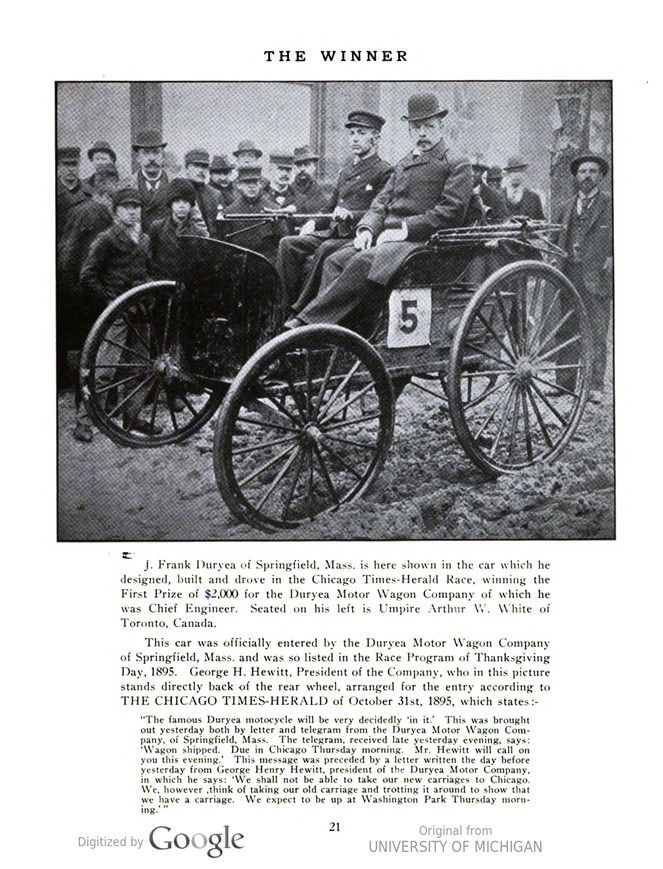
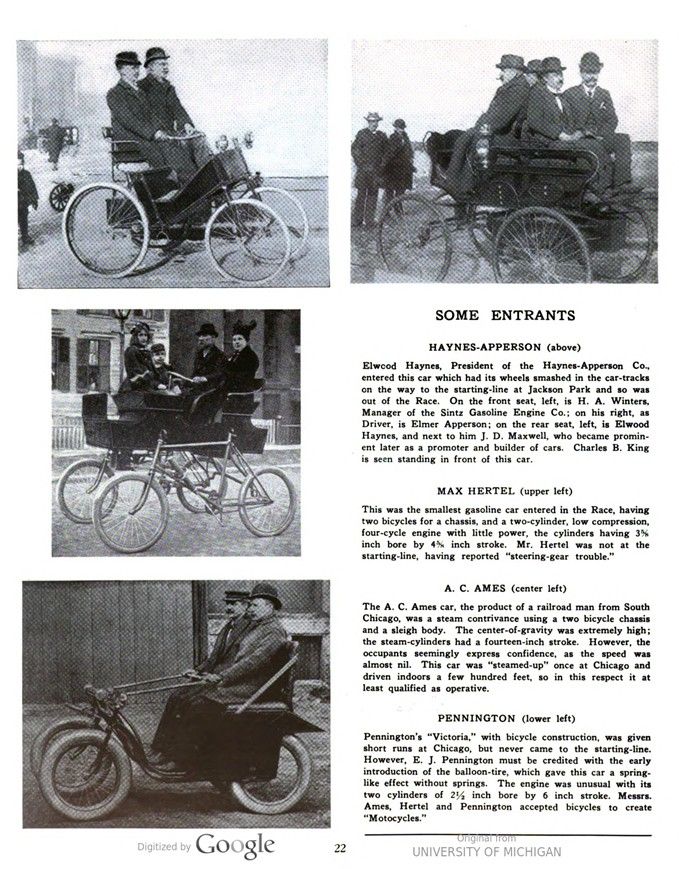
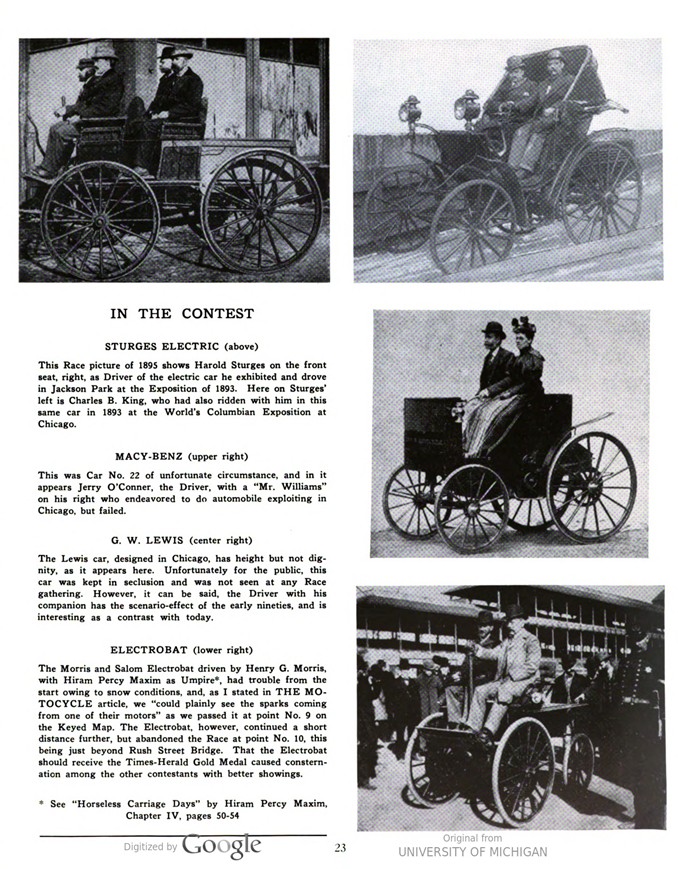
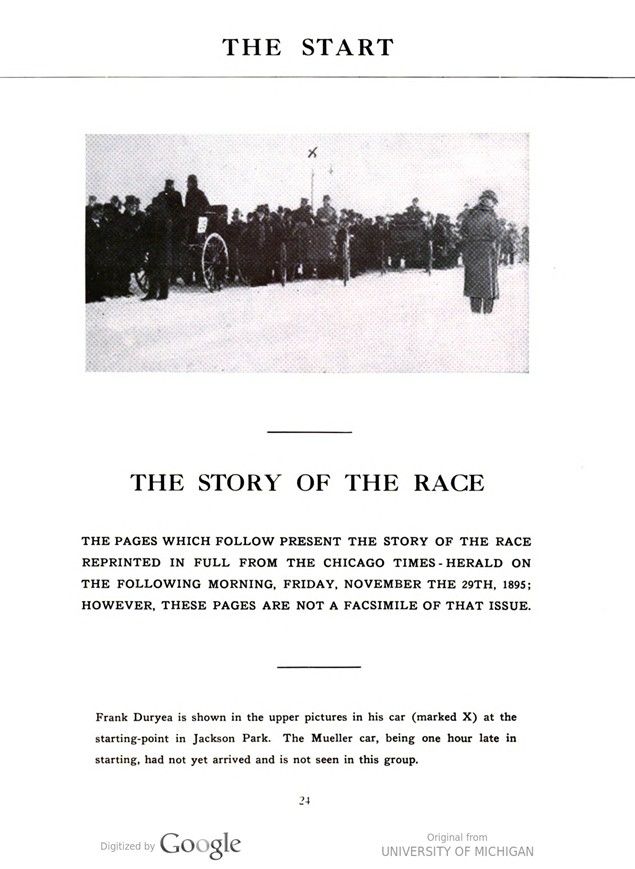
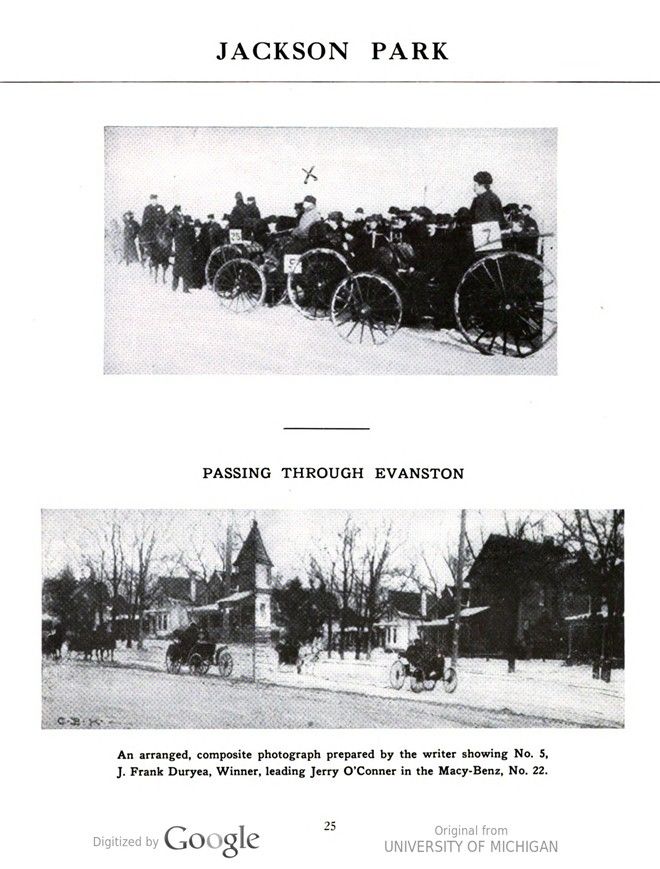
THE WINNER
J. Frank Duryea of Springfield, Mass. is here shown in the car which he designed, built and drove in the Chicago Times-Herald Race, winning the First Prize of $2,000 for the Duryea Motor Wagon Company of which he was Chief Engineer. Seated on his left is Umpire Arthur W. White of Toronto, Canada.
This car was officially entered by the Duryea Motor Wagon Company of Springfield, Mass. and was so listed in the Race Program of Thanksgiving Day, 1895. George H. Hewitt, President of the Company, who in this picture stands directly back of the rear wheel, arranged for the entry according to THE CHICAGO TIMES-HERALD of October 31st, 1895, which states:
„The famous Duryea motocycle will be very decidedly ‚in it.‘ This was brought out yesterday both by letter and telegram from the Duryea Motor Wagon Company, of Springfield, Mass. The telegram, received late yesterday evening, says: ‚Wagon shipped. Due in Chicago Thursday morning. Mr. Hewitt will call on you this evening.‘ This message was preceded by a letter written the day before yesterday from George Henry Hewitt, president of the Duryea Motor Company, in which he says: ‚We shall not be able to take our new carriages to Chicago. We, however, think of taking our old carriage and trotting it around to show that we have a carriage. We expect to be up at Washington Park Thursday morning.'“
SOME ENTRANTS IN THE CONTEST
HAYNES-APPERSON (above)
Elwood Haynes, President of the Haynes-Apperson Co., entered this car which had its wheels smashed in the car-tracks on the way to the starting-line at Jackson Park and so was out of the Race. On the front seat, left, is H. A. Winters, Manager of the Sintz Gasoline Engine Co.; on his right, as Driver, is Elmer Apperson; on the rear seat, left, is Elwood Haynes, and next to him J. D. Maxwell, who became prominent later as a promoter and builder of cars. Charles B. King is seen standing in front of this car.
MAX HERTEL (upper left)
This was the smallest gasoline car entered in the Race, having two bicycles for a chassis, and a two-cylinder, low compression, four-cycle engine with little power, the cylinders having 3-5/8 inch bore by 4-5/8-inch stroke. Mr. Hertel was not at the starting-line, having reported „steering-gear trouble.“
A. C. AMES (center left)
The A. C. Ames car, the product of a railroad man from South Chicago, was a steam contrivance using a two-bicycle chassis and a sleigh body. The center-of-gravity was extremely high; the steam-cylinders had a fourteen-inch stroke. However, the Occupants seemingly express confidence, as the speed was almost nil. This car was „steamed-up“ once at Chicago and driven indoors a few hundred feet, so in this respect it at least qualified as operative.
PENNINGTON (lower left)
Pennington’s „Victoria,“ with bicycle construction, was given short runs at Chicago, but never came to the starting line. However, E. J. Pennington must be credited with the early introduction of the balloon-tire, which gave this car a spring- like effect without springs. The engine was unusual with its two cylinders of 2½ inch bore by 6 inch stroke. Messrs. Ames, Hertel and Pennington accepted bicycles to create „Motocycles.“
STURGES ELECTRIC (above)
This Race picture of 1895 shows Harold Sturges on the front seat, right, as Driver of the electric car he exhibited and drove in Jackson Park at the Exposition of 1893. Here on Sturges‘ left is Charles B. King, who had also ridden with him in this same car in 1893 at the World’s Columbian Exposition at Chicago.
MACY-BENZ (upper right)
This was Car No. 22 of unfortunate circumstance, and in it appears Jerry O’Conner, the Driver, with a „Mr. Williams“ on his right who endeavored to do automobile exploiting in Chicago but failed.
G. W. LEWIS (center right)
The Lewis car, designed in Chicago, has height but not dignity, as it appears here. Unfortunately for the public, this car was kept in seclusion and was not seen at any Race gathering. However, it can be said, the Driver with his companion has the scenario-effect of the early nineties and is interesting as a contrast with today.
ELECTROBAT (lower right)
The Morris and Salom Electrobat driven by Henry G. Morris, with Hiram Percy Maxim as Umpire*, had trouble from the start owing to snow conditions, and, as I stated in THE MOTOCYCLE article, we „could plainly see the sparks coming from one of their motors“ as we passed it at point No. 9 on the Keyed Map. The Electrobat, however, continued a short distance further, but abandoned the Race at point No. 10, this being just beyond Rush Street Bridge. That the Electrobat should receive the Times-Herald Gold Medal caused consternation among the other contestants with better showings.
* See „Horseless Carriage Days“ by Hiram Percy Maxim, Chapter IV, pages 50-54 23
THE START – THE STORY OF THE RACE (Page 24-25)
THE PAGES WHICH FOLLOW PRESENT THE STORY OF THE RACE REPRINTED IN FULL FROM THE CHICAGO TIMES-HERALD ON THE FOLLOWING MORNING, FRIDAY, NOVEMBER THE 29TH, 1895; HOWEVER, THESE PAGES ARE NOT A FACSIMILE OF THAT ISSUE.
Frank Duryea is shown in the upper pictures in his car (marked X) at the starting point in Jackson Park. The Mueller car, being one hour late in starting, had not yet arrived and is not seen in this group.
JACKSON PARK – PASSING THROUGH EVANSTON
An arranged, composite photograph prepared by the writer showing No. 5, J. Frank Duryea, Winner, leading Jerry O’Conner in the Macy-Benz, No. 22.
